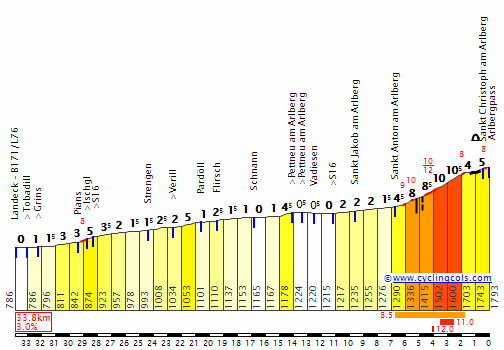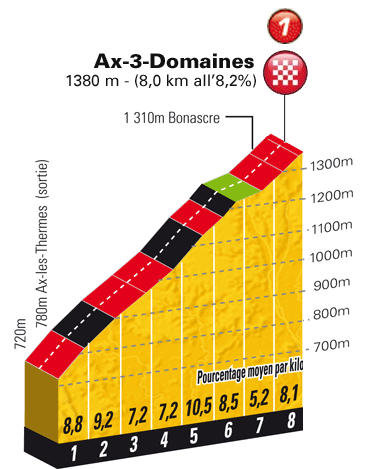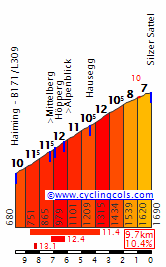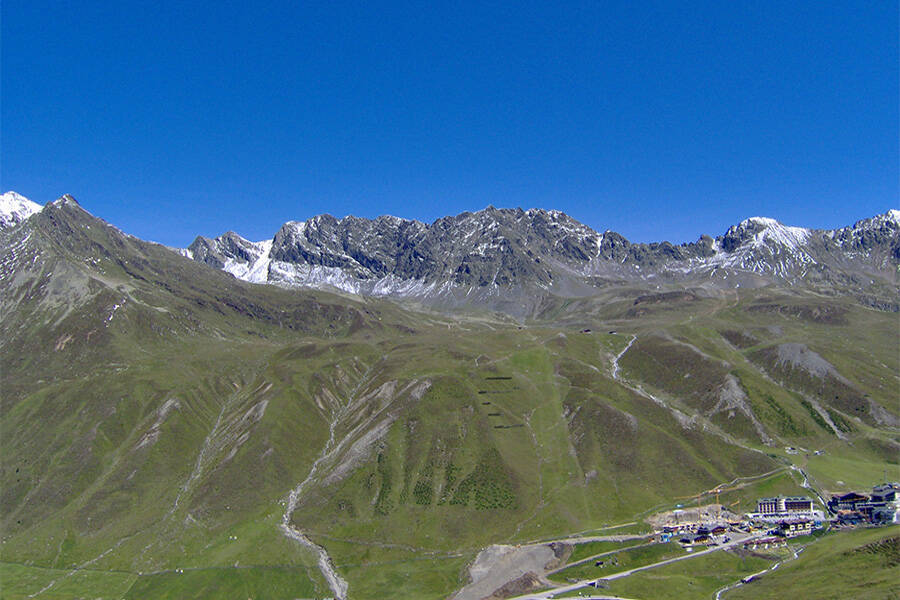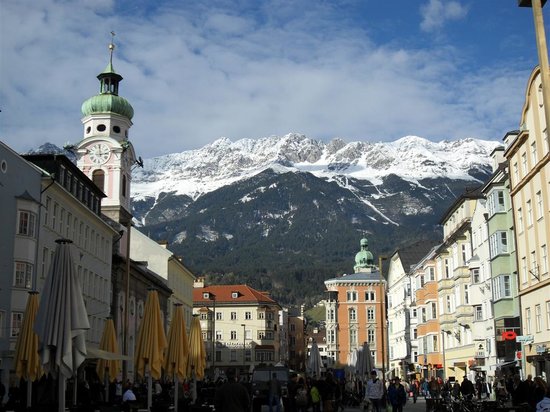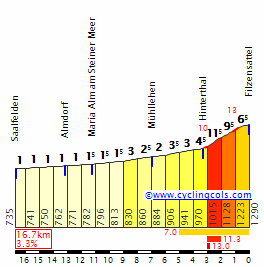Critérium du Dauphiné by railxmig - stage 2
I've tried to put some description but it balooned to an elaborated mess so i decided to screw this and just post an abstract of it.
library:
click here
Bourg-en-Bresse - Aillons-Margériaz, 213km, ~4050m asc, Mountain/MTF
Start: Bourg-en-Bresse, Avenue Paul Barberot
Km 0: Bourg-en-Bresse, Avenue Amédée Mercier, 3,5km from the start
Finish: Aillons-Margériaz, ski station, parking
Sprint: Oyonnax, Rue Jules Michelet, 450m straight
Feed zone: Bassy, Route de Challonges
Start - km 0:
Avenue Paul Barberot - Boulevard André Lévrier - Avenue Maginot - Rue du 19 Mars 1962 - Place Bernard - Cours de Verdun - Rue du 4 Septembre - Boulevard de Brou - Boulevard Saint-Nicolas - Place du Maquis Colonel Romans Petit - Avenue Amédée Mercier
List of climbs:
Col de Berthiand - 6,4km, 8%, 1 Cat. 780m
Côte de Samognat - 4,5km, 5,4%, 3 Cat. 634m
Côte d'Échallon - 8km, 5,3%, 2 Cat. 970m
Côte de Franclens - 4,4km, 4,3%, 4 Cat. 522m
Côte de Marcellette - 2,5km, 5%, 4 Cat. 493m
Mont Revard - 17,6km, 6,6%, HC Cat. 1463m
Col des Prés - 8.8km, 7,1%, 1 Cat. 1142m
Aillons-Margériaz (Stade de Neige du Margériaz) - 6,3km, 8%, 1 Cat. 1400m
Departaments:
Ain, start - 91,2km
Haute-Savoie, 91,2km - 148,7km
Savoie, 148,7km – finish
Preface:
Even if its just the 2nd stage it's one of hardest if not even the hardest stage in this race. It's the longest stage and the only one beyond 200km of this Dauphine. This stage is filled with mountains, hills and bumps. There are hardly any really flat sections – around 30kms of those. This stage can be separated into three parts:
first part – 0km – 73km. It's in the Jura mountains so it's obviously very bumpy. In span of 70kms there are three categorised climbs with cat. 1 being the toughest and a number of hills that could be categorised. It ends where the 3rd climb's descend ends;
second part – 73km – 155km. It's the flattest part of this stage and arguably the most touristically attractive. There are only two cat. 4 climbs in this part but not many really flat parts. It's still a bumpy terrain.
Third part – 155km – finish. It's the most montainous part as the stage goes through Massif des Bauges. It now goes fully into a real mountain stage as there are three climbs in quick succession, no one of them is below cat. 1.
Purpose:
It's the first stage of this Dauphine and it's allready very important to GC. It's purpose is to create as big gaps as there only can be between GC favourites, show off, who's lagging behind in prep and promote those, who actually were preparing for and targets Dauphine. Outcome of this stage can limit the risk of crashes in following stages. The stage does share some roads with my planned Tour so riders can adapt to them beforehand combining training and road recognition.
Start:
Stage will start in Bourg-en-Bresse on Avenue Paul Barberot. Bourg-en-Bresse has very rich history with cycling races. It hostes a lot of stages in Tour and Dauphine. Most of them were hilly parades through Jura (Faucille, Croix de la Serra, easier Berthiand etc.). It will start the Culoz stage in 2016 Tour with Berthiand from much harder side. The km 0 will be on Avenue Amédée Mercier [D979], 3,5km from the start. To reach km 0 peloton will follow:
Boulevard André Lévrier - Avenue Maginot - Rue du 19 Mars 1962 - Place Bernard - Cours de Verdun - Rue du 4 Septembre - Boulevard de Brou - Boulevard Saint-Nicolas - Place du Maquis Colonel Romans Petit.
Bourg-en-Bresse:
photo: Emilio Bertrand, 2013
Climbs:
Most of the climbs on this stage are known from Tour and Dauphine but are tackled from, most often, descended sides. Interestingly those sides are often harder than the more popular ones. Below is a list of categorised climbs to tackle and their short description.
Col de Berthiand (780m). The first climb of the day close to Montagne de Berthiand (836m) is
6,4km at 8%. It's a borderline 1/2 cat. I've promoted it to a cat. 1 because the first 2kms are very tough at 11%. Such percentages are quite rare on big and quite important roads (we're still on D979, Bourg-en-Bresse – Annecy road). Next kilometers towards the summit are progressively easier to flatten out on top. I think that profile below isn't most accurate but it's the only one i could find.
Côte de Samognat (634m). It's located just west of Oyonnax. It's
4,5km, 5,4%, that makes it a cat. 3 climb. It's quite consistent with slopes in between 5% and 6%.
Côte d'Échallon (970m) begins just after Oyonnax. It's a cat. 2 climb,
8km at 5,3%. It is simillar to the climb before, it's consistent with slopes in between 5% and 6% though first stretches still in Oyonnax are steeper. After the summit there is a small plateau before a long, shallow descend. It was present in Dauphine and Tour a bunch of times.
Côte de Franclens (522m). Climb simillar to Col de Berthiand but obviously shorter and shallower. It is a cat. 4 climb –
4,4km, 4,3%. It begins steep with 2km at 6,3% and progressively flattens towards the top.
Côte de Marcellette (493m). It's a cat. 4 climb,
2,5km, 5%. It's an opposite of it's predecessor. It begins as a false flat and progresively steepens towards the top with last km at 5,5%.
Mont Revard (1463m). There will be 3 climbs in this Dauphine that could be categorised as HC. This is the first one. It's a borderline 1/HC, promoted to HC because Dauphine is a smaller race. In Tour it would propably be a cat. 1. It's
17,6km at 6,6%. It's mostly a consistent climb with only one 1km long flat plateau in Trévignin 5,5km from the base of the climb. Most of the climb is between 7% and 8% with max. being 10%. It flattens on the top with 2km at 5,5%. The climb begins in Grésy-sur-Aix, just north of Aix-les-Bains and joins the main road (D913) in Trévignin. I think this side was never tackled in real Tour but will be partly present in my upcoming Tour. I don't know about Dauphine but propably not as this is the least known/popular side of this well known climb. Part of this climb up to Trévignin was present at the beginning of 2013 Dauphine stage 5 to Valmorel as a cat. 3 Côte de Trévignin, 4,4km at 6,6%. Last 1,5km in profile below are not included.
Col des Prés (1142m). It comes just after Monte Revard. It's much shorter than it's predecessor but steeper and less regular. It is a cat. 1 climb,
8.8km at 7,1%. This climb begins steep with 1km at 7,5% (max 10%) before reaching village of Thoiry. Then it slightly flattens for next 3km before again going steep with 3km at 8,5% (max 12%) before reaching last flat km. Descend of this climb is short and quite shallow. This climb quite regulary features in Tour and Dauphine, last time in Tour in 2013 from the different side. Part to Saint-Jean-d'Arvey in profile below is not included.
Aillons-Margériaz (Stade de Neige du Margériaz) (1400m). This is the MTF of this stage up to ski station Aillons-Margériaz. It comes after Col des Prés with 3km flat section in between. It is a cat. 1 climb,
6,3km at 8%. This climb is hardest in the middle with 2km at roughly 10%. First 2km are at around 8,3% and last 2km are flatter at 6,5%. I don't know if this climb featured in either Tour or Dauphine, i couldn't find any information about it. Propably it was in Dauphine in more historic times. Only last 6km of profile below are included.
Besides the climbs listed above there are plenty of other hills and bumps that are borderline into categorisation or just left uncategorised. Worth mentioning is
Col de la Roche (400m) located a couple of kms before Col de Berthiand. It is 1,4km at 7,2%. It could be a borderline 3/4 cat. It isn't categorised because there are enough categorised climbs on this stage and its location is unfortunate. Being close to Col de Berthiand and start of the stage proves for me to be problematic to put in the profile while not losing it's clarity. In real-life Dauphine or Tour it would be categorised and knowing the downward trend of categorisation nowadays it would be a cat. 3.
Sprint:
Today the sprint will be held after 52,2kms in the city of Oyonnax on Rue Jules Michelet at the end of 450m straight road. The road is two-lane, 6m wide. The sprint will be situated around 150m before railroad cross. It should be safe enough to not pose any or too much logistical problems. If not, then just move it like 100m before and it shouldn't cause any safety problems. The sprint should be won by a breakaway or a strong sprinter/fast puncher.
Feed zone:
Feed zone is located just outside town of Bassy on Route de Challonges after 102km from start, just before Seyssel.
Finish:
Finish will be held on the ski station Aillons-Margériaz (Stade de Neige du Margériaz is a parallel name) on top of a 6,3km, 8% climb. The station is in shadows of Mont Margériaz, 1845m (Massif Aillons-Margériaz). In the station is a triangle-shaped parking space at around 4000m^2. The space is approximately as big as was in Superdévoluy in 2013 (my own estimations using satelite view). It should be big enough to at least hold the most important cars and installations. I'm not sure if the buses could squeeze there and i don't see any closeby space to put them. Maybe just left them on D59 as it is a two-line road. I don't think it would pose much logistical and transport problems as this road doesn't seem to be of most importance or traffic heavy.
Roads:
Most of the roads are two-lane and their overall quality should be enough to hold a cycling race. There are some stretches that are narrower. There is almost two-lane, 5km long D31 Alby-sur-Chéran – Gruffy (135-140km), occasional narrowings in D14 Val-de-Fier (110-115km), a kilometre long D31 Pont de l'Abime – one-line around 3,5m wide (142-143km), and eventual narrowings in towns and cities. It makes less than 15km of roads narrower than a two-lane wide. The road to the finish, judging from satelites, is propably two-lane.
This stage uses 40kms of red roads (important ones that should be limited as much as possible for cycling tours) separated into three stretches: D979 Bourg-en-Bresse – Annecy road from 0-33,5km, D979 from 72-78km and D1201 from 134,3-135km. The stage doesn't interfeer with any autoroute or express road's junctions.
I'm not sure if I actualy can use Val de Fier as it can be a protected site, might collide with the dam and there is some risk of flooding or rock avalanches. All tunels are either short galleries or short and lightened so there shouldn't be much trouble with them. If there will be any problems with the road then I have prepared an alternative route via Vanzy – Frangy – Côte de Bossy (cat. 3 climb on D910 road) – Clermont‑en‑Genevois to link the roads in Vallières. I hope that there won't be any issues with Gorges du Sierroz.
Possible outcome:
Because it's the first stage of this Dauphine, amount of points to get for points and climbers jerseys and the first part of this stage being hilly, propability of a large breakaway is very high. The breakaway's size can cause a very hectic first kms with possibility of peloton breaking apart on Col de Berthiand. The race should slow down after either Col de Berthiand or on Côte d'Échallon (because sprint in Oyonnax) with the breakaway of non-contenders going away for 5-7 minutes.
The flatter central part of the stage should be used to slow down after the first part and to reorganize/prepare for upcoming difficulties. Propably somewhere there the TV cameras will be turned on so some of today's attractions could be shown. Difference to the breakaway can be at around 3-4 minutes.
Mont Revard is long and regular. It should be a good warm up for the last kilometers and provide big passive selection. On the top there could be around 30 riders in the peloton. Just as the descend ends Col des Prés begins. It can be either continuation of the selection up to like 15-20 riders at the top, stabilisation or first shy attacks by GC second tier contenders. I think propability of such attacks being succesful is quite low. Those two climbs should warm up the legs for the Aillons-Margériaz MTF looming ahead. The attacks for the win and GC propably will be around 4-3kms to the finish as those are the hardest moments (10%) on this climb. Last two kilometers are easier, so differences made by the attacks should at least hold.
Let's think about the most propable scenario. Differences between top 10 should be moderate – around 1:30 between 1st and 10th. Difference between first two at around 20-25sec. I think that 20th guy should be barely inside 5:00 mark and grupetto aroud 40 minutes down. Presence of the Jura climbs at the beginning could pose problems for some riders in trying to keep the loses inside time limit.
Tourist attractions:
Ceyzériat (6km) – Cascade de la Vallière
Hautecourt-Romanèche (16km) – Grotte de Hautecourt.
Izernore (37,2km) – important town in the Gallo-Roman era. It was one of the main towns of Bugey region (Grand Colombier). To this day there is a preserved Gallo-Roman temple.
Samognat/Metafelon (42,8km) – Barrage de Matafelon, Sauts de Charmine
Barrage de Génissiat (91km)
Seyssel (107km) – an interesting place as it's disjoined by Rhône river where the border between Haute-Savoie and Ain departaments is located. That's why officialy there are two Seyssels, the biger one in Haute-Savoie and smaller one in Ain.
Barrage de Seyssel – smaller than neighbouring Barrage de Génissiat, it's used to regulate the flow of the Rhône after Barrage de Génissiat.
Église Saint-Blaise de Seyssel – from VI century,
Pont de Seyssel – suspension bridge from 1838, one of the oldest of it's kind.
Vens (110km) – Château de Vens – stronghold used in history to protect the entrance to Val de Fier and was the home to lords of Vens.
Val de Fier (110-115km) – propably the most beatiful attraction we encounter on this stage. It's a sight more typical for Pyrenean valleys. I don't think it's as pretty as the, quote,
FEDAIA!!11oneone one (#libertine_s #steve_harvey #meat_missile #tickle_my_pickle) but it's not that far away. It's located between Montagne de Gros Foug (known for Mont Clergon and Col du Sapenay) on south side and Montagne des Princes on north side. On both sides the almost vertical drop is around 650-700m high with the river at roughly 270m and both plateaus over 900m. The road is slightly uphill and it goes through some galleries and one 100m long, lightened tunel. It has a varied width, most narrow (1,2 lane wide) around Barrage de Motz. It's a dam on Fier river just after the tunnel. The original road through Val de Fier was build by Romans. The valley ends after 5kms in Saint-André, a village belonging to Val-de-Fier commune. The road below is where the race will be held.
Val-de-Fier (115km) – to Val-de-Fier belongs Saint-André and Sion (2kms down the road) that is known from Romans times as Sedunum. In Saint-André you can find ruins of a church from V century while in Sion is Château de Sion from XIIIc. Attractions: Château de Sion, ruins of Église Saint-André.
Vallières (121km) – Pont Coppet – old (XVIIc.) stone bridge on an ancient Geneva – Chambery road.
Alby-sur-Chéran (135km) – in middle-ages was a part of a defensive system controlling the passage of Chéran river. In the commune there are six castles/strongholds: Le Châteauvieux, Château de Montconon, Château de Montdésir, Château de Montpon, Château de Montvuagnard, Château de Pierrecharve.
Gruffy (140,5km) – Château de Gruffy from IX century. Le Mollard – remains of human presence dating from the Neolithic period.
Pont de l'Abime, 545m (142,9km)
Gorges du Sierroz (151,5-154km) – part of Val de Sierroz just outside Grésy-sur-Aix. Popular tourist destination in XIX-XX century, closed in 1980, now a protected ecological site with a bunch of rare plants.
Grésy-sur-Aix (154,8km) – Château de Grésy – former stronghold from XIIc., Château des Contes de Loche, Château du Fontany ou Fontanil, Château de Mouxy, Église de Saint-Jean-Baptiste.
Mont Revard (173km) – Belvédère du Revard – outstanding views; too many photos to post here.












